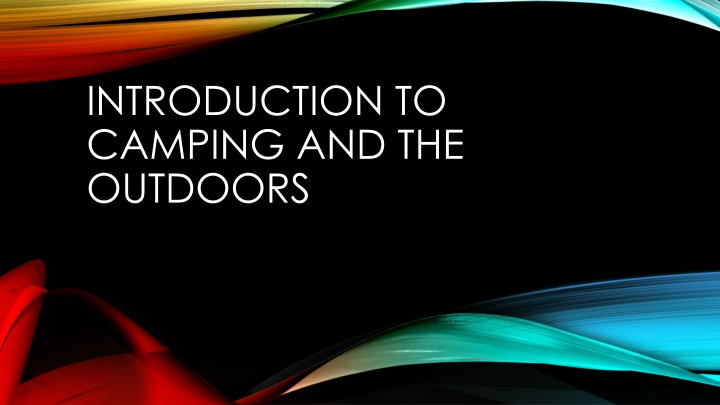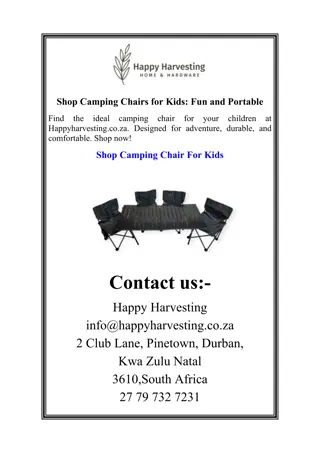Comprehensive Guide to Camping Safety and Essentials
Explore a comprehensive guide covering various aspects of camping safety and essentials, including choosing a campsite, fire safety rules, food temperature considerations, animal prevention methods, hygiene practices, water purification techniques, fuel precautions, equipment handling guidelines, and more. Stay informed to ensure a safe and enjoyable outdoor experience.
Download Presentation

Please find below an Image/Link to download the presentation.
The content on the website is provided AS IS for your information and personal use only. It may not be sold, licensed, or shared on other websites without obtaining consent from the author.If you encounter any issues during the download, it is possible that the publisher has removed the file from their server.
You are allowed to download the files provided on this website for personal or commercial use, subject to the condition that they are used lawfully. All files are the property of their respective owners.
The content on the website is provided AS IS for your information and personal use only. It may not be sold, licensed, or shared on other websites without obtaining consent from the author.
E N D
Presentation Transcript
INTRODUCTION TO CAMPING AND THE OUTDOORS
CHOOSING A CAMPSITE 6 W s of Camping You have just arrived at the car park of your proposed campsite. Divide yourselves into 6 groups and for 10 minutes discuss one of the W s in each group
CAMP SAFETY What are the local laws about camp fires in the UK? Unplanned fires can cause devastation to the countryside. You must always obtain permission from the landowner or occupier before you light a fire. Otherwise you may be liable to prosecution for criminal damage. Remember that smoking materials and matches can easily start fires, even if you stub them into the ground or into a litter bin. Always dispose of them with care. (Countryside Agency - 'Caring for the countryside ) List 10 rules for fire safety to consider when camping?
CAMP SAFETY Identify the temperatures the following foods should be kept at, and explain why this is important when camping: (a)Hot foods (b)Cold foods
CAMP SAFETY List 5 things you can do to prevent animals from coming into your campsite.
CAMP SAFETY What safety precautions should you consider when building a latrine/toilet?
CAMP SAFETY List 5 things to consider when practicing good hygiene at a campsite where there is no running water (i.e. showers, flush toilets, sinks, or tap water).
CAMP SAFETY Demonstrate 3 ways you can purify water when camping.
CAMP SAFETY Identify 2 types of fuel used for camp cooking and explain what precautions should be used when using each type of fuel.
CAMP SAFETY Discuss 5 guidelines for safely handling the following camping items: (a)knives (b)axes (c)saws (d)hatchets
ESSENTIAL EQUIPMENT Divide into 5 groups and list the essential equipment items for the following areas: Clothing Sleeping Cooking/Eating Safety First Aid Kit
KITCHEN /MESS TENT Food is secured against animals Food is stored at a safe temperature Kitchen and dishes are clean Fire extinguisher accessible and near stove Area is neat and free from tripping hazards
TENT ALLOCATON - SAFEGUARDING Adults and children in separate tents Boys' and girls' tents are properly separated
REFERENCES & LINKS http://www.investitureachievement.org/wiki/index.php/Adventist_Youth_Ho nors_Answer_Book Camp Safety Honour Camp Craft Honour https://www.gov.uk/government/publications/the-countryside-code The Countryside Code
VERNON NOEL AREA 7 CO-ORDINATOR T: 07956 409385 E: vernscape@gmail.com























